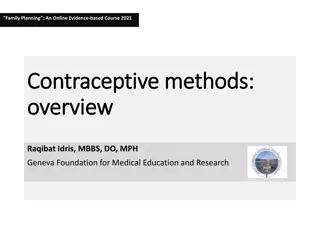Digital Health for Family Planning Systems Strengthening
High Impact Practices in Family Planning (HIPs) utilize digital technologies to enhance service delivery, address systemic barriers, and improve access to quality family planning services. The HIP Partnership involves experts and co-sponsors supporting evidence-based practices. Digital health applications offer better data for decision-making, enhanced provider capacity, and increased transparency and accountability in health systems.
Download Presentation

Please find below an Image/Link to download the presentation.
The content on the website is provided AS IS for your information and personal use only. It may not be sold, licensed, or shared on other websites without obtaining consent from the author.If you encounter any issues during the download, it is possible that the publisher has removed the file from their server.
You are allowed to download the files provided on this website for personal or commercial use, subject to the condition that they are used lawfully. All files are the property of their respective owners.
The content on the website is provided AS IS for your information and personal use only. It may not be sold, licensed, or shared on other websites without obtaining consent from the author.
E N D
Presentation Transcript
Digital Health for Systems Strengthening Family Planning Systems Through Time and Resource Efficiencies
Overview What is a HIP? HIP Categories Partnership 1. Introduction to the High Impact Practices (HIPs) Background Key Messages How can digital technologies enhance HIPs? 2. Digital Health for Systems Priority Research Questions Implementation Tips Tools & Resources 3. Extra Slides Digital Health for Systems 02
High Impact Practices in Family Planning (HIPs) are Vetted by experts against specific criteria Evidence-based family planning practices Documented in an easy-to-use format Digital Health for Systems 03
HIPs address the full spectrum of FP programming Service Delivery Social and Behavioral Change Enabling Environment Improve the availability, accessibility, acceptability, and quality of family planning services. 8 briefs Address systemic barriers that affect an individual s ability to access family planning information & services. 6 briefs Influence knowledge, beliefs, behaviors, and social norms associated with family planning. 3 briefs Enhancements Approaches used in conjunction with HIPs to maximize the impact of HIP implementation or increase the reach. 4 briefs Digital Health for Systems 04
HIP Partnership The Technical Advisory Group (TAG) is made up of 25 experts in family planning, including representatives from the co-sponsors. The Co-sponsors include the following organizations: Digital Health for Systems 05
High Impact Practice Use digital technologies to support health systems and service delivery for family planning. Digital Health for Systems 06
Background Digital health applications for health systems and providers can support implementation of HIPs by offering: Better data for decision making with virtually real-time reporting of services and commodities Improved provider capacity through continuous learning, digital provider tools, and mobile supervision Increased transparency, efficiency, and accountability through digital financial services Digital Health for Systems 07
Key Messages Family planning indicators should be incorporated into new and existing digital health and logistics management information systems. More research is needed about when and how digital applications for provider support are most effective, efficient, and scalable. Mobile money and electronic financial transactions have the potential to provide efficiency and transparency of health care financing and transactions. Digital Health for Systems 08
How can digital technologies enhance HIPs? Illustrative Examples of How Digital Technologies Can Enhance HIPs 05 Digital Health for Systems 09
How can digital technologies enhance HIPs? Better Data for Decision Making Digital applications can be used to manage logistics and reduce contraceptive stock- outs. Digital Health for Systems 10
How can digital technologies enhance HIPs? Illustrative Examples of Digital Health Information Systems Digital national health management information systems allow for timely analysis, data visualization, and reporting. 05 Digital Health for Systems 11
How can digital technologies enhance HIPs? Improved Provider Capacity As a complement to in-person trainings, digital applications can improve clinical knowledge through refresher trainings and continuous learning opportunities for remote service providers. Digital applications may improve client-provider interactions by offering on-demand, comprehensive, and accurate information and referrals. Digital Health for Systems 12
How can digital technologies enhance HIPs? Improved Provider Capacity Digital applications may provide a cost-effective option for remote supportive supervision. Improved Efficiency, Accountability, and Transparency of Financial Transactions Mobile money can be leveraged to increase efficiency and transparency of financial transactions. Digital Health for Systems 13
Thank You Continue to the extra slides or access the HIP brief for more information. Digital Health for Systems 14
Extra Slides Priority Research Questions Implementation Tips Tools & Resources Digital Health for Systems 15
Priority Research Questions In what circumstances is the use of digital health interventions in family planning most cost-effective for offering training, training follow-up, or continuing education to providers? In what circumstances are digital health interventions most cost-effective for use in contraceptive counseling and screening? In what circumstances are digital health interventions in family planning cost-effective compared with non-digital interventions? Do digital applications that support family planning systems contribute to client-level outcomes such as the modern contraceptive prevalence rate? 05 Digital Health for Systems 16
Implementation Tips Gather information about and from the intended users of the digital intervention. Understand the overall technology landscape, including available infrastructure, existing programs, opportunities for interoperability, and potential technology partners. Determine the potential scale for the project and the resources necessary for its long-term operation. Digital Health for Systems 17
Implementation Tips Consider realistic options for sustainable financing. Monitor the implementation and performance of your digital health service. Digital Health for Systems 18
Tools & Resources mHealth Assessment and Planning for Scale (MAPS) Toolkit Principles for Digital Development mHealth Planning Guide Global Digital Health Network 05 Digital Health for Systems 19























